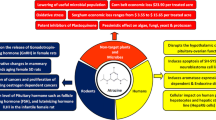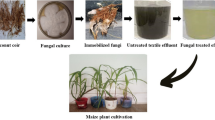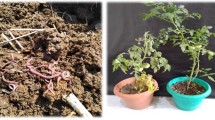Abstract
In order to evaluate the ability of three types of extracts to explain the ecotoxicological risk of treated municipal sewage sludges, the OECD 208A germination test was applied using three plants (Lolium perenne L., Brassica rapa L., and Trifolium pratense L.). Three equivalent batches of sludge, remained as dewatered sludge, composted with plant remains and thermally dried, from an anaerobic waste water treatment plant were separated. Samples from these three batches were extracted in water, methanol, and dichloromethane. Plant bioassays were performed and the Germination Index (GI) for the three plants was evaluated once after a period of 10 days. Germination in extracts was always lower than the respective controls. The germination in composted sludge (GI 40.9–86.2) was higher than the dewatered (GI 2.9–45.8), or thermally dried sludges (GI 24.6–64.4). A comparison of the germination between types of extracts showed differences for dewatered sludge with the three plants, where the water and methanol extracts had significantly lower germination than the dichloromethane extract. A higher half maximal effective concentration (EC50) in composted extracts was established, mainly in the water extract (EC50 431–490 g kg−1). On the contrary, the germination was strongly inhibited in the water extract of the dewatered sludge (EC50 14 g kg−1). The germination was positively correlated with the degree of organic matter stability of the parent sludge, and an inverse correlation was detected for total nitrogen, hydrolysable nitrogen and ammonium content. It is concluded that the phytotoxic effect of the water extract is more closely related to hydrophilic substances rather than lipophilic ones, and care must be taken with dewatered sludge application, especially with their aqueous eluates. Results obtained in this work show the suitability of the use of sludge extracts in ecotoxic assays and emphasize the relevance of sewage sludge stabilization by post-treatment processes.

Similar content being viewed by others
References
An YJ (2004) Soil ecotoxicity assessment using cadmium sensitive plants. Environ Pollut 1271:21–26. doi:10.1016/S0269-7491(03)00263-X
Bagó B, Martin Y, Mejia G, Broto-Puig F, Diaz-Ferrero J, Agut M et al (2005) Di-(2-ethylhexyl)phthalate in sewage sludge and post-treated sludge: quantitative determination by HRGC-MS and mass spectral characterization. Chemosphere 598:1191–1195. doi:10.1016/j.chemosphere.2004.11.077
Brack W (2003) Effect-directed analysis: a promising tool for the identification of organic toxicants in complex mixtures? Anal Bioanal Chem 3773:397–407. doi:10.1007/s00216-003-2139-z
Busetti F, Heitz A, Cuomo M, Badoer S, Traverso P (2006) Determination of sixteen polycyclic aromatic hydrocarbons in aqueous and solid samples from an Italian wastewater treatment plant. J Chromatogr A 11021–2:104–115. doi:10.1016/j.chroma.2005.10.013
Cole LJ, McCracken DI, Foster GN, Aitken MN (2001) Using Collembola to assess the risks of applying metal-rich sewage sludge to agricultural land in western Scotland. Agric Ecosyst Environ 831–2:177–189. doi:10.1016/S0167-8809(00)00172-9
Cook SV, Chu A, Goodman RH (2002) Leachability and toxicity of hydrocarbons, metals and salt contamination from flare pit soil. Water Air Soil Pollut 1331–4:297–314. doi:10.1023/A:1012925812698
Dauden A, Quilez D (2004) Pig slurry versus mineral fertilization on corn yield and nitrate leaching in a Mediterranean irrigated environment. Eur J Agron 211:7–19. doi:10.1016/S1161-0301(03)00056-X
De la Torre AI, Jimenez JA, Carballo M, Fernandez C, Roset J, Munoz MJ (2000) Ecotoxicological evaluation of pig slurry. Chemosphere 4110:1629–1635. doi:10.1016/S0045-6535(00)00038-2
Déportes I, Benoit-Guyod JL, Zmirou D (1995) Hazard to man and the environment posed by the use of urban waste compost—a review. Sci Total Environ 1722–3:197–222. doi:10.1016/0048-9697(95)04808-1
Domene X, Alcañiz JM, Andrés P (2007) Comparision of solid-phase and eluate assays to gauge the ecotoxicological risk of organic wastes on soil organisms. J Envpol Doi:10.1016/j.envpol.2007.04.007
Düring R, Gäth S (2002) Utilization of municipal organic wastes in agriculture: where do we stand, where will we go? J Plant Nutr Soil Sci 165:544–556
EC (2000) Working document on sludge: 3rd draft. Brussels, Belgium
Fernandez MD, Vega MM, Tarazona JV (2006) Risk-based ecological soil quality criteria for the characterization of contaminated soils. Combination of chemical and biological tools. Sci Total Environ 366:466–484
Fuentes A, Llorens M, Saez MJ, Aguilar I, Perez-Marin AB, Ortuno JF et al (2006) Ecotoxicity, phytotoxicity, and extractability of heavy metals from different stabilised sewage sludges. Environ Pollut 1432:355–360. doi:10.1016/j.envpol.2005.11.035
Garcia C, Hernandez T, Costa F (1991) Study on water extract of sewage-sludge composts. Soil Sci Plant Nutr 37:399–408
Gong P, Wilke BM, Strozzi E, Fleischmann S (2001) Evaluation and refinement of a continuous seed germination and early seedling growth test for the use in the ecotoxicological assessment of soils. Chemosphere 443:491–500. doi:10.1016/S0045-6535(00)00280-0
Graja S, Chauzy J, Fernandes P, Patria L, Cretenot D (2005) Reduction of sludge production from WWTP using thermal pretreatment and enhanced anaerobic methanisation. Water Sci Technol 5212:267–273
Grube M, Lin JG, Lee PH, Kokorevicha S (2006) Evaluation of sewage sludge-based compost by FT-IR spectroscopy. Geoderma 1303–4:324–333. doi:10.1016/j.geoderma.2005.02.005
Hamdi H, Manusadzianas L, Aoyama I, Jedidi N (2006) Effects of anthracene, pyrene, and benzo[a]pyrene spiking and sewage sludge compost amendment on soil ecotoxicity during a bioremediation process. Chemosphere 657:1153–1162. doi:10.1016/j.chemosphere.2006.03.065
Hoekstra NJ, Bosker T, Lantinga EA (2002) Effects of cattle dung from farms with different feeding strategies on germination and initial root growth of cress (Lepidium sativum L.). Agric Ecosyst Environ 931–3:189–196. doi:10.1016/S0167-8809(01)00348-6
ISO (1996) Water quality—determination of 33 elements by inductively coupled plasma atomic emission spectroscopy. ISO 11885. International Organization for Standardization, Geneve, Switzerland
Jorba M, Andrés P (2000) Effects of sewage sludge on the establishment of the herbaceous ground cover after soil restoration. J Soil Water Conserv 553:322–327
Larney FJ, Sullivan DM, Buckley KE, Eghball B (2006) The role of composting in recycling manure nutrients. Can J Soil Sci 864:597–611
Lima JS, de Queiroz JEG, Freitas HB (2004) Effect of selected and non-selected urban waste compost on the initial growth of corn. Resources Conserv Recycling 424:309–315
Martins O, Dewes T (1992) Loss of nitrogenous compounds during composting of animal wastes. Bioresour Technol 422:103–111. doi:10.1016/0960-8524(92)90068-9
Marttinen SK, Hanninen K, Rintala JA (2004) Removal of DEHP in composting and aeration of sewage sludge. Sci Total Environ 543:265–272
McMillen SJ, vanGestel CAM, Lanno RP, Linder GL, Pauwels SJ, Stephenson GL (2003). Biological measures of bioavailability In: McMillen SJ, vanGestel CAM, Lanno RP, Linder GL, Pauwels SJ, Stephenson GL (eds) Contaminated soils: from soil–chemical interactions to ecosystem management. Society of environmental toxicology and chemistry (SETAC), SETAC Press, Pensacola
Migliore L, Cozzolino S, Fiori M (2003) Phytotoxicity to and uptake of enrofloxacin in crop plants. Chemosphere 527:1233–1244. doi:10.1016/S0045-6535(03)00272-8
Neyens E, Baeyens J (2003) A review of thermal sludge pre-treatment processes to improve dewaterability. J Hazard Mater 981–3:51–67. doi:10.1016/S0304-3894(02)00320-5
OECD (1984) (Organization for Economic Cooperation and Development), Guideline for testing of chemicals No 208: Terrestrial plant growth test. Paris
Pascual JA, Ayuso M, Garcia C, Hernandez T (1997) Characterization of urban wastes according to fertility and phytotoxicity parameters. Waste Manag Res 151:103–112
Petrovic M, Barceló D (2000) Determination of anionic and nonionic surfactants, their degradation products, and endocrine-disrupting compounds in sewage sludge by liquid chromatography/mass spectrometry. Anal Chem 7219:4560–4567. doi:10.1021/ac000306o
Ramírez WA, Domene X, Ortiz O, Alcañiz JM (2008) Toxic effects of digested, composted and thermally-dried sewage sludge on three plants. J Biortech 99:7168–7175. doi:10.1016/j.biortech.2007.12.072
Renoux AY, Tyagi RD, Samson R (2001) Assessment of toxicity reduction after metal removal in bioleached sewage sludge. Water Res 356:1415–1424. doi:10.1016/S0043-1354(00)00400-0
Renoux AY, Rocheleau S, Sarrazin M, Sunahara GI, Blais JF (2007) Assessment of a sewage sludge treatment on cadmium, copper, and zinc bioavailability in barley, ryegrass and earthworms. Environ Pollut 1451:41–50. doi:10.1016/j.envpol.2006.04.001
Rovira P, Vallejo VR (2002) Labile and recalcitrant pools of carbon and nitrogen in organic matter decomposing at different depths in soil: an acid hydrolysis approach. Geoderma 1071–2:109–141. doi:10.1016/S0016-7061(01)00143-4
Sopper WE (1993) Municipal sludge use in land reclamation, vol 1. Lewis Publishers, Boca Raton, USA
Srivastava R, Kumar D, Gupta SK (2005) Municipal sludge-induced phytotoxicity. Atla-Altern Lab Anim 335:501–508
Stasta P, Boran J, Bebar L, Oral J (2006) Thermal processing of sewage sludge. Appl Therm Eng 2613:1420–1426. doi:10.1016/j.applthermaleng.2005.05.030
Tiquia SM, Tam NFY, Hodgkiss IJ (1996) Effects of composting on phytotoxicity of spent pig-manure sawdust litter. Environ Pollut 933:249–256. doi:10.1016/S0269-7491(96)00052-8
Walter I, Martinez F, Cala V (2006) Heavy metal speciation and phytotoxic effects of three representative sewage sludges for agricultural uses. Environ Pollut 1393:507–514. doi:10.1016/j.envpol.2005.05.020
Wang X, Sun C, Gao S, Wang L, Shuokui L (2001) Validation of germination rate and root elongation as indicator to asses phytotoxicity with Cucumis sativus. Chemosphere 44:1711–1721. doi:10.1016/S0045-6535(00)00520-8
Winfield LE, Rodgers JH, D’Surney SJ (2004) The responses of selected terrestrial plants to short (<12 days) and long-term (2, 4, and 6 weeks) hexahydro-1, 3, 5-trinitro-1, 3, 5-triazine (RDX) exposure Part I: Growth and developmental effects. Ecotoxicology 134:335–347. doi:10.1023/B:ECTX.0000033091.78180.3d
Acknowledgments
This project was financially supported by the AGL2002-03297 project of the Spanish Ministry of Education and Science, and CTM2006-14163-C02-01 of the Spanish Environment Ministry. The first author received a special doctoral scholarship funded by the Agencia Española de Cooperación Internacional (AECI).
Author information
Authors and Affiliations
Corresponding author
Rights and permissions
About this article
Cite this article
Ramírez, W.A., Domene, X., Andrés, P. et al. Phytotoxic effects of sewage sludge extracts on the germination of three plant species. Ecotoxicology 17, 834–844 (2008). https://doi.org/10.1007/s10646-008-0246-5
Received:
Accepted:
Published:
Issue Date:
DOI: https://doi.org/10.1007/s10646-008-0246-5




